Technological wonders
Wearing and wielding items
Using a technological wonder’s properties might mean wearing or wielding it. A technological wonder meant to be worn must be donned in the intended fashion: boots go on the feet, gloves on the hands, hats and helmets on the head, and rings on the finger. Technological armor must be donned, a shield strapped to the arm, a cloak fastened about the shoulders. A weapon must be held.
In most cases, a technological wonder that’s meant to be worn can fit a creature regardless of size or build. Many technological garments are made to be easily adjustable. Rare exceptions exist. If the story suggests a good reason for an item to fit only creatures of a certain size or shape, you can rule that it doesn’t adjust. For example, drow-made armor might fit elves only. Dwarves might make items usable only by dwarf-sized and dwarf-shaped folk.
When a nonhumanoid tries to wear an item, use your discretion as to whether the item functions as intended. A ring placed on a tentacle might work, but a nagaji with a snakelike tail instead of legs can’t wear boots.
Multiple items of the same kind
Use common sense to determine whether more than one of a given kind of technological wonder can be worn. A character can’t normally wear more than one pair of boots, one pair of gloves or gauntlets, one pair of bracers, one suit of armor, one item of headwear, and one cloak. You can make exceptions; a character might be able to wear a circlet under a helmet, for example, or to layer two cloaks.
Technological wonders
Armor
Unless an armor’s description says otherwise, armor must be worn for its magic to function.
Some suits of armor specify the type of armor they are, such as chain hauberk or plate. If an armor doesn’t specify its armor type, you may choose the type or determine it randomly.
Animated Shield
shield, very rare (requires attunement)While holding this shield, you can speak its command word to cause it to animate. The shield leaps into the air and hovers in your space to protect you as if you were wielding it, leaving your hands free. The shield remains animated for 1 minute, until you dismiss it (no action required), or until you are incapacitated or die, at which point the shield falls to the ground or into your hand if you have one free.
Chameleon Suit

This suit of light woven-fiber covers the wearer from ankle to wrist and includes a hooded cowl. It can be worn over light armor. Its surface consists of millions of tiny, scale-like lenses and LED screens. When powered on, a chameleon suit analyzes its environment and generates digital camouflage. The wearer has advantage on Stealth checks and can hide in plain sight.
The device has a capacity of 50 charges and uses 1 charge every minute while active.
Deep Diving Suit

A deep diving suit is a body-tight mesh of reinforced rubber and polymer that is fitted with scrubbers that can draw and purify oxygen from its surrounding environment, extracting oxygen from water as easily as from air. The suit’s helmet is close-fitting but offers excellent visibility, while the suit’s fabric itself can flex while still remaining supportive against pressure—depths are treated as being 400 meters shallower than their actual depth for the purposes of determining pressure damage from deep water. The wearer is also immune to inhaled toxins and can breathe underwater with ease—the suit does not allow breathing in a vacuum.
A diving suit’s hands and feet can activate webbing, long fins, and flippers, which the wearer can extend (and deactivate) once on its turn. While in this mode, the wearer of the suit gains a swim speed of 5 meters, but the wearer’s walking speed is reduced by 1 meter.
The device has a capacity of 25 charges and uses 1 charge every hour while active.
Gravity Suit

A gravity suit consists of several black, flexible straps attached to a framework of delicate servos, thin plates, and small strips of black polymer plastic. The suit slows any fall as if the wearer were under the effect of a feather fall spell.
At the cost of 1 additional charge per minute, the wearer of a gravity suit can fly at a speed of 10 meters. Activating this ability is an action.
The device has a capacity of 25 charges and uses 1 charge every hour while active.
HEV Suit

Short for “hazardous environment,” an HEV suit provides protection from radiation, disease, poisonous gas, cold, heat, and similar environmental dangers. The suit needs a power supply to work—while deactivated, none of the following abilities function at all.
While powered, the suit provides immunity to inhaled poisons and diseases, and provides resistance against all forms of energy except for concussion damage. An HEV suit completely protects against low radiation, and reduces the effects of medium radiation to low radiation, but it offers no protection against high or severe radiation. The suit’s self-repairing polymer resin fabric automatically seals secondary punctures or tears created by physical attacks to the wearer and damage dealt specifically against the suit.
The device has a capacity of 25 charges and uses 1 charge every hour while active.
Inssuit
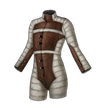
This padded jumpsuit is made of resilient polymers interwoven with superconducting thread. It provides resistance against cold, acid, and lightning damage.
Nanite Ablative
chain or scale,This suit of armor consists of several layers of scaly mesh over a thick, clothlike polymer weave. When activated, a suit of nanite ablative armor grants the wearer additional protection against nanites, through the use of imperceptible magnetic fields that repel the microscopic robots. An active suit of nanite ablative grants +3 Defense to the wearer’s Defense against nanite-based attacks. The wearer has advantage on saving throws made against nanite-related effects.
The device has a capacity of 10 charges and uses 1 charge every hour while active.
Panic Suit

When not being worn, a panic suit is a fist-sized plastic sphere. When activated, it envelops the creature holding it in a full-body protective suit. While activated, it provides immunity to low radiation. Its air filters grant advantage on saving throws against inhaled poisons and diseases.
A panic suit is a single-use item. When its charges run out or its wearer deactivates it, it falls apart into useless fragments.
The device has a capacity of 10 charges and uses 1 charge every hour while active.
Powered Armor

Powered armor represents the pinnacle of personal armor—a suit crafted of multiple skymetals and other materials designed to augment the wearer in numerous ways. While wearing this armor, you gain a +1 bonus to Defense and your walking speed increases by 2 meters. In addition, the armor’s gloves turn unarmed strikes with your hands into magic weapons that you are proficient with that deal bludgeoning damage, with a +1 bonus to attacks and damage rolls and a damage die of 1d8. Powered armor protects against energy and the environment as if it were a spacesuit. Powered armor has a damage threshold of 20 and 300 health. Powered armor is fitted with numerous small booster jets that grant the wearer a fly speed of 10 meters in areas of no gravity and 5 meters in gravity.
As an action, the wearer may activate the armor’s self-repair system. The armor consumes a single charge and repairs 2d6 damage. Only 1 charge can be consumed per turn for this effect.
In addition, the following technological wonders are integrated into a suit of powered armor—each of these devices drains power from the suit’s charges as appropriate when they are activated and used.
- Camera in the helmet.
- Commset in the helmet.
- Fire extinguisher mounted on the left wrist.
- Flashlight mounted on the helmet.
- Gloves that can function as grippers.
- Laser pistol mounted on the right forearm that leaves the hand free. Firing this laser pistol is always considered an off-hand attack, and the number of times it can be fired cannot be increased by feats like Improved Two-Weapon Fighting.
- Magboots.
- Three medlances. Each medlance can be loaded with a single potion or pharmaceutical; You can activate an integrated medlance without using an action.
- Power receiver.
- Prismatic force field located on hips; activating this force field is an action.
- Radiation detector on the right wrist.
- Veemod which gives all the benefits of Brown, Black, White, Gray, and Green veemods.
Rumors persist of variant forms of powered armor, including suits sized for giants or that can function as vehicles for multiple creatures.
The device has a capacity of 100 charges.
Scatterlight Suit

A scatterlight suit is a tight, form-fitting suit of highly reflective polymers and synthetic metal fibers. It’s designed to reflect beam weapon attacks. Activating a scatterlight suit is an action; once activated, the suit diffuses and blurs light reflected from its surface, making the wearer appear hazy and indistinct.
While active, the wearer has +3 Defense against beam-based attacks.
The device has a capacity of 25 charges and uses 1 charge every hour while active.
Spacesuit

This airtight suit of synthetic polymers includes a transparent, dome-like helmet that completely covers the wearer’s head. A spacesuit is nearly identical in function to an HEV suit, except that as long as the spacesuit is charged, it provides complete protection from all radiation and exposure to vacuum.
A space suit is fitted with numerous small booster jets that grant the wearer a fly speed of 5 meters in areas of zero gravity while the spacesuit is charged. The boosters impart no benefit in areas of high, low, or normal gravity.
The device has a capacity of 25 charges and uses 1 charge every hour while sealed or flying.
Artisan’s Tools
| Name | Cost | Weight |
|---|---|---|
| Tinker’s Tools | 50 sp | 4 kg |
These special tools include the items needed to pursue a craft or trade. The table shows examples of the most common types of tools, each providing items related to a single craft.
Tinker’s Tools
(50 sp, 4 kg)Tinker’s tools include wrenches, screwdrivers, pliers, gears, bits of shaped metal, magnifying eye glasses. Tinker’s tools enable a character to craft useful items.
Cybertech
| Name | Cost | Weight |
|---|---|---|
| Biofilter | 16,000 sp | 1 kg |
| Cranial Bomb | 4,500 sp | ¼ kg |
| Cyberart | 100 sp | — |
| Cyberfiber Muscles | — | 5 kg |
| Cybernetic Arm | 4,250 sp | 4 kg |
| Cybernetic Ears | 4,000 sp | ½ kg |
| Cybernetic Eyes | 4,000 sp | ½ kg |
| Cybernetic Leg | 4,250 sp | 6 kg |
| Dermal Plating | — | 2 kg |
| Implanted Weaponry | 1,000 sp | — |
| Skillslot | 2,000 sp | ½ kg |
| Thoracic Nanite Chamber | — | 5 kg |
| Wirejack Tendons | — | 5 kg |
Cybertech is a form of technology that must be surgically implanted into a host body before it functions. Cybertech takes up a special set of slots that correspond to a creature’s body. Most cybertech is designed for a creature with a humanoid shape—installing cybertech in a non-humanoid-shaped body is more difficult, but possible.
Each piece of cybertech has an implantation value that indicates how invasive the implant is. The total combined implantation values of all cybertech implanted in a single creature can’t exceed 10 + that creature’s Constitution or Intelligence—a creature’s Constitution sets the physical limit of what its body can accept in the form of cybernetic implants, while the creature’s Intelligence sets the mental limit of what its brain can control. An implants whose implantation value would cause the total to exceed either of these two does not function but still takes up a body slot. In addition, as long as a character has cybernetic implants installed whose combined implantation exceeds their Constitution or Intelligence, it has disadvantage on all saving throws.
A creature with neither a Constitution nor an Intelligence cannot receive benefits from cybertech, but a creature with only one of these can.
Installing a piece of cybertech takes a number of hours equal to twice the cybertech’s implantation value if the installation is done by hand—certain technological items can speed this installation time. The target must be willing or helpless during the entire installation, at the end of which the installer attempts a Medicine check against the cybertech’s Install Difficulty—this specific value is listed for each cybertech item for ease of reference. The target gains exhausted levels equal to the cybertech’s implantation value. On a success the cybertech immediately activates. On a failed check, the installation fails; a new attempt to install the cybertech can be made, although it’s wise to wait for the exhausted condition to subside before trying again.
Cybertech can be extracted using the same procedure as implanting it, with a failed Medicine check indicating the attempt to extract the item failed. Fortunately, extraction is a simpler task than installment, and Medicine skill checks to remove cybertech gain a +5 bonus. Extracting a piece of cybertech from a dead body requires no Medicine check but takes a number of rounds equal to the cybertech’s implantation value. You can only install or extract a single piece of cybertech at a time.
An NPC generally charges an amount equal to 10% the total price of a piece of cybertech for the service of installing the item.
Biofilter

A nanite matrix is installed in the kidneys and liver to help purge the body of toxins. A biofilter provides advantage on saving throws against disease and poison.
Cranial Bomb

A cranial bomb is a bomb implanted at the base of the skull that explodes when remotely activated by a detonator’s signal. Though normally implanted, a cranial bomb can also be detonated outside of a body. If detonated while implanted, it deals 6d6 bludgeoning damage and 6d6 fire damage. If detonated outside a body, the bomb instead creates a small explosion, dealing the half damage detailed above in a 1-meter radius burst (Reflex Difficulty 13 or half).
Cyberart
(100 sp, )Cyberart is the least invasive of all cybertech. This implant is similar in appearance to a tattoo, except that it can glow softly if desired, providing illumination equal to that provided by a candle. Some cyberart is animated, providing a short looping scene that replays over and over. Cyberart is installed in a body with a small metallic stylus that injects low-grade nanites into a body part; the quality of the art relies on the installer’s Sleight of Hand check.
Cyberfiber Muscles
| Variant | Implantation | Install Difficulty | Ability | Cost |
|---|---|---|---|---|
| Mark I | 2 | +1 | 10,000 sp | |
| Mark II | 4 | +2 | 25,000 sp | |
| Mark III | 6 | +3 | 50,000 sp |

Cyberfiber muscles are powerful synthetic muscles that augment but do not replace existing muscle mass in a creature. Once installed, cyberfiber muscles grant a bonus to your Strength based on the mark.
Cybernetic Arm

A cybernetic arm completely replaces a normal arm, from the shoulder to the hand. It can take the place of an arm lost to a severing wound. The arm is fully functional and no different in appearance from a regular arm, although cyberart can be added to the arm at no additional cost. If a creature has two cybernetic arms, it can lift and carry double the normal maximum weight for that creature’s Strength and size.
Cybernetic Ears
(4,000 sp, ½ kg)When a pair of ears is installed, the user has advantage on all skill checks based on sound.
A cybernetic ear can be enhanced by cyberart at no additional cost, giving it an unusual color or shape.
Cybernetic Eyes
(4,000 sp, ½ kg)When a pair of eyes is installed, the user gains advantage on all skill checks based on sight and advantage on all saving throws against blindness or visual effects. A pair of cybernetic eyes can be further enhanced by one veemod at a price equal to 1.5 times the veemod’s normal price.
A cybernetic eye can be enhanced by cyber art for no additional cost, giving it an unusual color or pattern.
Cybernetic Leg

A cybernetic leg completely replaces a normal leg, from the hip to the foot. It can take the place of a leg lost to a severing wound. The leg is fully functional and no different in appearance from a regular leg, although cyberart can be added to the leg at no additional cost. If both legs are replaced, they increase the user’s land speed by 2 meters.
Dermal Plating
| Variant | Implantation | Install Difficulty | Defense bonus | Cost |
|---|---|---|---|---|
| Mark I | 2 | 4,000 sp | ||
| Mark II | 4 | 16,000 sp | ||
| Mark III | 6 | 36,000 sp |

Dermal plating consists of sheets of highly resistant bioplastics anchored directly onto the patient’s skin. Once installed, dermal plating grants a bonus to your Defense based on the mark.
Implanted Weaponry

A single light melee weapon or one-handed energy weapon can be implanted in an arm or cybernetic arm. Melee weapons can extend or retract once on your turn. Ranged weapons fire through a port on the palm or back of the wrist. Either type of weapon has statistics identical to its normal form. Implanted weapons are well concealed; detecting one requires a thorough search (Difficulty 20). Implanted weaponry cannot be disarmed. Weaponry installed in a cybernetic arm does not count against a creature’s implantation limit. The cost, price, and weight of the weapon to be implanted are added to the cost listed.
Skillslot

A skillslot is implanted into the target’s brain, leaving a small port at the base of the skull. This port is covered with a flap of skin when not in use. Once installed, a skillslot has no effect until a skillchip is inserted into the port. It takes 10 minutes for a skillchip to adjust itself to a new skillslot; during this time, the user has disadvantage on all skill checks as distracting sensations flood its mind. When a skillchip is removed, its benefits end immediately, but the wearer suffers no ill effects.
Thoracic Nanite Chamber
| Variant | Implantation | Install Difficulty | Ability | Cost |
|---|---|---|---|---|
| Mark I | 2 | +1 | 10,000 sp | |
| Mark II | 4 | +2 | 25,000 sp | |
| Mark III | 6 | +3 | 50,000 sp |

A thoracic nanite chamber augments the vital organs within a creature’s chest, particularly its heart, lungs, and pulmonary system. Once installed, thoracic nanite chamber grant a bonus to your Constitution based on the mark.
Wirejack Tendons
| Variant | Implantation | Install Difficulty | Ability | Cost |
|---|---|---|---|---|
| Mark I | 2 | +1 | 10,000 sp | |
| Mark II | 4 | +2 | 25,000 sp | |
| Mark III | 6 | +3 | 50,000 sp |

Wirejack tendons not only strengthen and enhance existing reflexes, but also enhance the transmission of nerve impulses to surrounding musculature. Once installed, wirejack tendons grant a bonus to your Dexterity based on the mark.
Enhance checks
| Name | Cost | Weight |
|---|---|---|
| Skillchip | 3,000 sp | ⅒ kg |
| Trauma Pack | 188 sp | 2 kg |
Skillchip

A skillchip contains a wealth of knowledge and lore concerning a single skill. In order for a user to access a skillchip’s lore, it must be inserted into an active skillslot. While inserted, the user is capable, or proficient if they are already capable, with that skill.
Trauma Pack
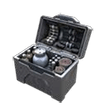
This small box of emergency medical gear can be used to augment a creature’s Medicine skill to allow for enhanced healing. A full trauma pack has enough supplies to be used 5 times before it is depleted. When you make a Medicine check to Stabilize, you can expend one use of the kit to gain advantage on the check. Additionally, on a success the target regains 2d4 + 2 health.
Grenades
| Name | Cost | Weight |
|---|---|---|
| Arc Grenade | 415 sp | ½ kg |
| Concussion Grenade | 415 sp | ½ kg |
| EMP Grenade | 415 sp | ½ kg |
| Flash Grenade | 415 sp | ½ kg |
| Fragmentation Grenade | 415 sp | ½ kg |
| Gas Grenade | 415 sp | ½ kg |
| Gravity Grenade | 600 sp | ½ kg |
| Inferno Grenade | 415 sp | ½ kg |
| Plasma Grenade | 825 sp | ½ kg |
| Smoke Grenade | 55 sp | ½ kg |
| Thundering Grenade | 500 sp | ½ kg |
| Zero Grenade | 415 sp | ½ kg |
A grenade is a small, cylindrical device that is designed to be thrown or fired from a grenade launcher. Before being thrown by hand, the grenade must be primed with a quick twist of a dial at one end and then armed with a click of a button at the center of that dial (no action required). As an action, a character can throw a grenade at a point up to 5 meters away. With a grenade launcher, the character can propel the grenade up to 20 meters away.
Arc Grenade
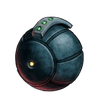
Each creature within 4 meters must make a Difficulty 15 Reflex saving throw. On a failure, a creature takes 5d6 lightning damage. On a success, a creature takes half as much damage.
Concussion Grenade
(415 sp, ½ kg)Each creature within 4 meters must make a Difficulty 15 Reflex saving throw. On a failure, a creature takes 5d6 bludgeoning damage. On a success, a creature takes half as much damage.
EMP Grenade
(415 sp, ½ kg)Each cyborg, android, robot, or electronic-based gear within 4 meters must make a Difficulty 15 Reflex saving throw. On a failure, a creature takes 5d6 lightning damage. On a success, a creature takes half as much damage.
Flash Grenade
(415 sp, ½ kg)Each creature within 4 meters must make a Difficulty 15 Fortitude saving throw. On a failure, a creature is blinded and deafened for 1 minute. A creature can repeat the saving throw at the end of each of its turns, ending the effect on itself on a success.
Fragmentation Grenade
(415 sp, ½ kg)Each creature within 4 meters must make a Difficulty 15 Reflex saving throw. On a failure, a creature takes 5d6 piercing damage. On a success, a creature takes half as much damage.
Gas Grenade
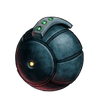
Each creature within 4 meters must make a Difficulty 15 Fortitude saving throw. On a failure, a creature is poisoned for 1 minute. The gas lingers for 1 minute. A creature can repeat the saving throw at the end of each of its turns, ending the effect on itself on a success.
Gravity Grenade
(600 sp, ½ kg)Each creature within 4 meters must make a Difficulty 15 Reflex saving throw. On a failure, a creature takes 5d6 force damage and is knocked prone. On a success, a creature takes half as much damage.
Inferno Grenade
(415 sp, ½ kg)Each creature within 4 meters must make a Difficulty 15 Reflex saving throw. On a failure, a creature takes 5d6 fire damage. On a success, a creature takes half as much damage.
Plasma Grenade
(825 sp, ½ kg)Each creature within 4 meters must make a Difficulty 15 Reflex saving throw. On a failure, a creature takes 4d6 fire damage and 4d6 lightning damage. On a success, a creature takes half as much damage.
Smoke Grenade
(55 sp, ½ kg)A smoke grenade emits a cloud of smoke that creates a heavily obscured area in a 4-meter radius. A moderate wind (at least 15 kilometers per hour) disperses the smoke in 4 rounds; a strong wind (at least 30 kilometers per hour) disperses it in 1 round.
Thundering Grenade
(500 sp, ½ kg)Each creature within 4 meters must make a Difficulty 15 Reflex saving throw. On a failure, a creature takes 5d6 force damage and is deafened for 1 minute. On a success, a creature takes half as much damage. A creature can repeat the saving throw at the end of each of its turns, ending the effect on itself on a success.
Zero Grenade
(415 sp, ½ kg)Each creature within 4 meters must make a Difficulty 15 Reflex saving throw. On a failure, a creature takes 5d6 cold damage. On a success, a creature takes half as much damage.
Headwear
| Name | Cost | Weight |
|---|---|---|
| Envoy’s Mouthpiece | 2,000 sp | ½ kg |
| Filter Mask | 4,500 sp | ½ kg |
| Neurocam | 36,000 sp | 1 kg |
| Proximity Helmet | 2,000 sp | 1 kg |
| Psychic Imprinter | — | 5 kg |
| Veemod Goggles | 1,000 sp | ¼ kg |
Unless a headwear’s description says otherwise, it must be worn for it to function.
Envoy’s Mouthpiece

Originally worn by translators, messengers, and diplomats, these objects were always constructed to appear elegant and beautiful. An envoy’s mouthpiece is a circlet worn across the mouth, with slender arms that reach along the jaw to wrap around the wearer’s skull and hold the device in place. Two thin earpieces extend up from the band to slip unobtrusively into the user’s ears once a mouth piece is donned. When created, an envoy’s mouthpiece is encoded with two specific languages. Whenever the encoded language is spoken within 5 meters of the wearer, the mouthpiece translates that language into the second language. In addition, any words spoken in the second language by the wearer are transformed by the mouthpiece into the encoded language, allowing conversation to take place between the wearer and speakers of the encoded language.
An envoy’s mouthpiece can not be used to translate languages other than the one it has been programmed to translate, but a newly created mouth piece could, in theory, translate languages into something other than the second language. An envoy’s mouthpiece automatically records any words spoken through it, allowing anything said through the device to be replayed through its earpiece at the touch of a button on the lower right side. Up to 30 continuous hours can be recorded in this manner. Holding the button down for a full round erases any currently stored conversations.
The device has a capacity of 10 charges and uses 1 charge every hour.
Filter Mask
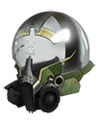
A filter mask is a clear plastic shield worn over the entire face. The mask has ionized filters and scrubbers that purify the air the user breathes in and give the mask an unintentionally fearsome look. While the mask has power, the wearer is completely immune to inhaled toxins or diseases. Even when the mask has no power, it grants the wearer advantage on all saving throws made to resist airborne toxins and diseases.
The device has a capacity of 10 charges and uses 1 charge every hour.
Neurocam

A neurocam consists of a strange helmet covered in flashing lights and adjustable straps with an intricate blinder that covers the eyes. This device is used to make a duplicate of a creature’s mind, copying and storing all the knowledge, memories, and personality of a living creature. A neurocam can be adjusted to fit the head of any creature of size Small to Large. A neurocam interfaces with the subject’s brain via a modulated beam of light that is transmitted through the optic nerves and several fine sensors that must press against the user’s skull. Storing a person’s mind takes 10 minutes of uninterrupted use; any interruption scrambles the pattern and ruins the neurocam. This process does not harm the target. An unwilling subject can attempt a Difficulty 17 Will saving throw to resist a neurocam; if the subject is successful, the neurocam’s contents are scrambled and the device is ruined.
A neurocam can store only one personality. Once used, it cannot store another even after the contents are uploaded elsewhere. A personality stored in a neurocam is effectively put into stasis—the mind does not age, nor does it gain new experiences or knowledge. It’s cut off from the world, and though it experiences strange dreams, it isn’t aware of the passage of time. If the neurocam is destroyed, the stored personality vanishes; however, loss of power does not harm a stored personality.
A stored personality can be uploaded only once. It can be uploaded into a blank clone in a clonepod. Additional processes to upload a stored personality into a robot or an AI core exist but are complex and often drive the stored personality insane.
Proximity Helmet
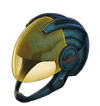
This open-faced, blue polymer helmet includes a nylon strap and adjustable tinted visor capable of hiding all but the wearer’s mouth and chin. The interior of the tinted faceplate provides a heads-up display when activated, with each charge providing enough power to function for 1 hour of continuous use. During this time, the helmet’s external motion sensors pick up on sudden movements and subtle visual cues, granting the wearer advantage on Perception checks to notice moving targets within 20 meters. A secondary setting on the helmet adds an audible alarm that creates a loud chirping sound near the wearer’s ear whenever a Small or larger corporeal creature approaches within 20 meters. Reduce this distance by 5 meters for each interposing closed door and by 5 meters for each substantial interposing wall. This noise is loud enough to waken the wearer from sleep, but not loud enough to awaken nearby sleepers.
The device has a capacity of 10 charges and uses 1 charge every hour.
Psychic Imprinter

A more advanced version of the neurocam, a psychic imprinter resembles a helmet with a closed and opaque visor. It can be adjusted to fit over the head a Small, Medium, or Large humanoid. In its recording mode, it records a complete mental image of that creator into its data banks. This functions as a neurocam’s recording mode, except the Difficulty for the Will save to resist is 22. This image remains until a new recording overwrites it.
In its imprinting mode, the device writes its stored mental image over the mind of the creature wearing it, destroying the creature’s original memories and personality in the process. The target retains its physical abilities, species abilities, and any species Health Dice. Its game statistics are replaced by the statistics of the image, but it retains its personality, and Strength, Dexterity, and Constitution. It also retains all of its skill and saving throw aptitudes. A successful Difficulty 22 Will saving throw negates erasure. An imprinter can be set to record the mental image of the target as the device overwrites its mind. Otherwise, the old personality is utterly destroyed in the process, beyond the reach of all means except a miracle or wish spell, or divine intervention.
Stored memories can be transferred between neurocams and psychic imprinters without consuming charges from either device.
The device has a capacity of 20 charges and uses 1 charge for every substance analyzed.
Veemod Goggles
| Color | Usage | Cost |
|---|---|---|
| Brown | 1 charge/day | 500 sp |
| Black | 1 charge/hr | 1,000 sp |
| White | 1 charge/hr | 2,000 sp |
| Gray | 1 charge/hr | 4,000 sp |
| Green | 1 charge/hr | 30,000 sp |
| Red | 1 charge/10 minutes | 40,000 sp |
| Blue | 1 charge/10 minutes | 50,000 sp |
| Prismatic | 1 charge/round | 90,000 sp |

These goggles come in a variety of colors and shapes, but most are sleek and streamlined in appearance. The primary use for these goggles is to enhance vision via the application of a “vision enhancement module,” or “veemod.” A pair of veemod goggles can be fitted with only one veemod at a time; attaching a veemod is a Use an Object action.
The device has a capacity of 10 charges and uses charges based on the lens used.
Veemods are color-coded items, and provide the following benefits.
Illumination
| Name | Cost | Weight |
|---|---|---|
| Flashlight | 30 sp | ½ kg |
Flashlight
common, (30 sp, ½ kg)When activated, a flashlight creates a beam of bright light in a 10-meter cone. It also increases the light level in the area beyond this initial cone by one step (from darkness to dim, or from dim to bright), out to a 20-meter cone. A flashlight has no effect in areas of magical darkness.
The device has a capacity of 10 charges and uses 1 charge every 8 hours.
Miscellaneous
| Name | Cost | Weight |
|---|---|---|
| Autodoc | — | 550 kg |
| Clonepod | 60,000 sp | 45 kg |
| Extinction Wave Device | — | 450 kg |
| Power Relay | — | 25 kg |
| Rebirthing Chamber | — | 550 kg |
Autodoc

An autodoc is a large, cumbersome device that consists of a comfortable, plastic-framed reclining chair inside a transparent pod, within which is affixed a dizzying array of multi-jointed arms and extendable devices. An equally dizzying assortment of buttons, lights, and touch-sensitive screens adorn the device, both on the inside and outside of the pod.
An autodoc can heal wounds, set broken bones, cure disease, treat burns, implant cybertech, remove poison, and more. An autodoc can be programmed to perform any number of surgical procedures upon the person lying within the pod—the dozens of arms and devices work with precision and great speed. The operator need only enter in the proper diagnosis or desired operation on the screens at the foot of the bed with a successful Medicine check. The Difficulty is based on the operation, detailed below. An autodoc will not activate until it has been properly programmed. Programming an operation takes 2d6 rounds of work. An autodoc has some capacity to error-check and auto-complete the correct programming for an operation before undertaking it by running instantaneous simulations on one of its many screens, granting the user advantage on these Medicine checks.
While functioning, an autodoc is closed tight—a successful Difficulty 23 Brawn check is required to wrench the door open. A patient who leaves or is forcibly removed from an autodoc before an operation finishes (or who is being operated on when the autodoc runs out of charges) must succeed a Difficulty 14 Reflex saving throw or take 3d6 + 10 damage from the cutting lasers, surgical tools, and needles moving at high speed. Needless to say, exiting the autodoc before an operation completes negates any of the benefits that would have been otherwise granted by the device.
The various operations an autodoc can perform are as follows; additional operations can be devised as needed.
- Minor Surgery (Difficulty 10): The patient heals 1d8 + 1 damage. Operation Time: 1 minute.
- Moderate Surgery (Difficulty 15): The patient regains 2d8 + 3 health and removes the blinded, deafened, or poisoned condition. Operation Time: 2 minutes.
- Major Surgery (Difficulty 20): The patient heals 3d8 + 5 and is cured of blindness and deafness. Operation Time: 3 minutes.
- Critical Surgery (Difficulty 24): The patient heals 4d8 + 7 and removes any reductions to one of its abilities, remove one effect that reduces its maximum health, remove one effect that charmed or petrified it, or reduce its exhausted level by one. Operation Time: 4 minutes.
- Back from the brink (Difficulty 28): A dead patient whose body is relatively intact is restored to life at 1 health. Operation Time: 1 hour.
- Total molecular Reconstruction (Difficulty 38): As long as at least a small amount of a patient’s DNA is available, an autodoc can reconstruct a patient’s body completely. At the end of the reconstruction process, the new body is considered to be a blank clone of the patient, and until the patient’s memories and personality are implanted into the clone via a neurocam, the body remains alive but inert. Operation Time: 24 hours.
- Install Cybertech (Difficulty = the cybertech install Difficulty): Cybernetic equipment is installed safely. Operation Time: 10 minutes per point of implantation of the cybertech being installed.
- Treat Toxin (Difficulty = 5 + the save Difficulty of disease or poison): The patient has one disease or poison currently afflicting them removed. Operation Time: 10 minutes.
An autodoc has a capacity of 120 charges consumes 1 charge per hour while idle (including time needed to program an operation), and 1 charge per round while operating. As an autodoc can only hold a maximum of 120 charges at a time, for lengthy operations it must be recharged during use or be attached to a standing power supply such as a generator or reactor.
Clonepod

A clonepod looks like a human-sized capsule with a blue window at head height and a bank of touch-sensitive screens and buttons at chest height. A small slot situated below the window can accept genetic material (fingernails, hair clippings, skin samples, and so forth). When genetic material is placed in the slot, the clonepod immediately atomizes the sample and processes the genetic information. At this point, activating the clonepod causes its interior to flood with blue biotic fluid, which is then supersaturated with a combination of proteins, nanites, and other materials. Over the course of the next 12 hours, the clonepod works nonstop to produce an exact replica of the creature from which the genetic material was harvested, as the creature was when the sample was taken. A clonepod can only duplicate a Medium or smaller creature.
The completed clone can remain in stasis inside the pod indefinitely as long as the seals are not broken. The clone created is alive, yet has no mind until a neurocam is used to upload a mind into the clone’s brain. A clone has the same Strength, Dexterity, and Constitution of the original body. A clone that is awoken before any mind is uploaded into it has an Intelligence, Wisdom, and Charisma of −4.
Uploading a mind from a neurocam into a clone takes 10 minutes. If the mind belonged to the same creature that was used to grow the clone, it immediately comes back to life as if under the effects of a clone spell—provided the user’s soul has not yet passed to the Boneyard and been judged. It possesses the same Intelligence, Wisdom, and Charisma of the original mind, all of that creature’s skills, and most of the memories and personality of the creature (though there may be gaps or differences).
If the clone’s body and mind are not from the same source, all six abilities are permanently reduced by 1.
The device has a capacity of 200 charges and uses 20 charges each time it is used.
Extinction Wave Device
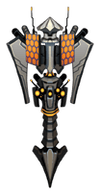
An extinction wave device is a devastating and ruinous weapon. When activated by a remote detonator, this bomb explodes in a spherical wash of reality-warping radiation, killing virtually all living creatures with an Intelligence in a 2-kilometer radius, while leaving structures and simple life forms intact. Each creature in the area must make a Difficulty 24 Fortitude saving throw. On a failure, a creature dies instantly. On a success, it takes 10d8 damage. Unlike signals, an extinction wave is not hampered by most solid barriers and other materials, but force barriers with 25 or more health and metals alloyed with djezet block it. An extinction wave is a mind-affecting death effect.
These statistics are for an extinction wave device designed to target command and control centers. Smaller and larger extinction wave devices exist. For example, a portable wave extinction device delivers a 300-meter radius effect and weighs 20 kilos.
Power Relay
artifact, (25 kg)A power relay is a valuable device that allows the long-distance transmission of energy from a nearby generator to a device that can make use of it. Every power generator has a built-in power transmitter that allows for the transmission of power to a nearby power receiver, but an external power relay is required to send this energy beyond the generator’s limitations. A power relay consumes 10 charges when it is activated (As an action), after which it automatically links to the closest generator within 400 meters that has an available yield. This distance is halved for every meter of metal or 4 meters of solid stone between the generator and the power relay.
The power relay has a capacity of 10 and consumes 1 charge of the generator’s available yield per hour to maintain its own power supplies, and can be programmed to transmit any remaining charges of available yield to any object capable of receiving broadcast power, to a maximum distance of 250 kilometers. This distance is halved for every meter of metal or 4 meters of solid stone between the generator and the power relay.
Power transmitted by this device is lost unless the device is programmed to transmit to a specific target capable of accepting a charge in range. Before a power relay can transmit, it must be linked to the target of its transmission to establish the transmission protocols. This consumes 10 charges and takes 1 minute to complete. Once completed, the distance between the power relay and the target of its transmissions can vary up to its maximum range. A small screen on the side of the power relay provides constant updates on the link, including bearings, distances, and the nature of the object to which it is linked.
This device essentially functions as a power generator that provides an hourly yield of charges to its target. For example, if a power relay that provided a yield of 40 charges was linked to a laser pistol, that laser pistol could be fired 40 times per hour without needing an additional charge.
Power relays can only function a limited number of times before their delicate internal mechanisms burn out. Each time a power relay is used to initiate a new energy transfer, there’s a cumulative 20% chance it burns out and becomes useless.
Once a new transfer begins, a power relay can maintain that link between the generator and its target indefinitely (as long as there’s always an available yield of at least 1 charge from the generator to keep itself powered).
Note that a power relay has built-in signal boosters, and thus the range of its transmissions cannot be further increased through the use of additional signal boosters.
Rebirthing Chamber

This enclosed pod of metal and plastic contains a thinly padded bed on which to lay, and dozens of small vents along its interior. A rebirthing chamber cannot operate on its own power, and must be attached to an external power source. When a Small or Medium humanoid lies within a rebirthing chamber, the chamber automatically seals as soporific gas fills the chamber. Each round the creature must succeed on a Difficulty 22 Fortitude saving throw or a deathlike coma is induced (poison effect). One minute after it seals, the chamber floods with nanites that first analyze, then reduce the occupant to its component molecules. The creature must make a Difficulty 22 Fortitude saving throw. On a failure, it takes 6d10 bludgeoning damage as it is dismantled. On a success, it takes half as much damage. The process is horrifically painful process should the occupant retain consciousness. Any gear worn by the occupant is dismantled and destroyed, with possibly catastrophic results for explosives and powered devices.
Over the next 1d4 days, the nanites reconstruct and enhance the occupant, in effect optimizing its genetic code.
The occupant wakes up with full memories of its prior existence, but in the body of a young adult of its species, halfway between the minimum and maximum age of its current age category. In the process, all six abilities are permanently increased by 1.
Each time a rebirthing chamber is used, there is a 10% chance its nanite reconstruction fails, leaving the host dead and without remains. Only a resurrection spell, a miracle spell, or a wish spell can restore such a hapless victim. The nanite reservoir contains sufficient nanites for five rebirths, assuming it hasn’t been previously used.
A rebirthing chamber only works on humanoids and humanoid corporeal undead. It can even restore life to a long-dead corpse, so long as usable genetic information remains, but with a 25% chance of failure instead of 10%. For each day that passed without preservation such as gentle repose, the revived creature loses roughly 10% of its memories and loses 1 level. If the levels lost exceed the creature’s level, the revival fails. Intelligent corporeal undead retain their memories after revival, but lose all undead abilities and regain their original statistics and abilities from their time among the living.
Attempts to rebirth a creature without a soul invariably fail, as do attempts to rebirth a creature from partial remains while the creature is still alive. A body is created and draws breath, but lacks any intellect and dies 2d6 hours after the process completed.
The device uses 200 charges every day.
Necessities
| Name | Cost | Weight |
|---|---|---|
| Goo Tube | 6 sp | 0.05 kg |
Goo Tube

Goo tubes are a form of preserved food. A single goo tube is a malleable cylinder with a cap on one end; when it’s opened and squeezed, the colorful, goopy contents are extruded. Although the texture and appearance of this goo is unappetizing, the paste is actually quite tasty, and comes in a mind-boggling assortment of flavors. A symbol on the side of the tube often grants a clue as to what flavor may be contained within, but these symbols can sometimes be counter-intuitive. The contents of a single goo tube can provide nourishment for a day for one Medium-size creature.
Pharmaceuticals
| Name | Cost | Weight |
|---|---|---|
| Baseline | 725 sp | ⅒ kg |
| Cardioamp | 725 sp | ⅒ kg |
| Cureall | 175 sp | ⅒ kg |
| Greater Cureall | 1,125 sp | ⅒ kg |
| Hemochem | — | ⅒ kg |
| Hype | 50 sp | ⅒ kg |
| Soothe | — | ⅒ kg |
| Torpinal | 175 sp | ⅒ kg |
| Universal Serum | 175 sp | ⅒ kg |
| Zortaphen | 1,125 sp | ⅒ kg |
Pharmaceuticals include drugs, poisons, and medicines. They can be ingested or injected, and generally have relatively minor or temporary effects.
A pharmaceutical takes an action to consume, or as a Use an Object action if administered by a medlance. Individual doses of pharmaceuticals can take various forms, from an injected serum to an ingested pill. Each pharmaceutical is assumed to contain a means of delivery included in its weight and cost. Any pharmaceutical can be used with a medlance to speed up its administration time, regardless of its form.
Baseline

An injection of baseline floods the brain with neuroinhibitors that purge the mind of excess emotion. Baseline has an onset time of 10 minutes. When it takes effect, the recipient has advantage on Will saving throws for 1 hour, as well as suppressing (but not removing) any such active, ongoing effects. It can be resisted with a successful Difficulty 14 Fortitude saving throw. Once a creature has been affected by baseline, it cannot be affected by additional doses for 24 hours.
Cardioamp

This potent drug can revive a recently deceased victim. If administered to a corpse within 1 minute of death, the victim can immediately attempt a Difficulty 14 Fortitude saving throw to return to life with 1 health. Cardioamp can’t return to life a creature that has died of old age, nor can it restore any missing body parts. Cardioamp can be deadly if injected into a living creature. A living creature injected with cardioamp must succeed on a Difficulty 14 Fortitude saving throw or take 6d6 necrotic damage from a sudden heart attack. If the save is successful, the damage is negated but the victim becomes poisoned for 1 hour.
Greater Cureall
rare, (1,125 sp, ⅒ kg)Greater cureall can end a debilitating effect. It can remove the blinded, deafened, or poisoned condition or any reductions to one ability, remove one effect that reduces maximum health, remove one effect that charmed, paralyzed, or petrified, or reduce an exhausted level by one.
Hemochem
| Variant | Ongoing | Cost |
|---|---|---|
| Grade I | 1 | 50 sp |
| Grade II | 2 | 150 sp |
| Grade III | 3 | 375 sp |
| Grade IV | 4 | 750 sp |
| Grade V | 5 | 1,000 sp |

Hemochem stops bleeding and promotes healing. A single dose of hemochem lasts for 1 minute. While you are affected by hemochem you regain an amount of health at the start of its turn for 1 minute as specified in the variant. Multiple doses injected do not stack, but they do reset the duration back to 1 minute.
Hype

A synthetic adrenaline derivative once used by soldiers, hype boosts perception and reaction time but comes with some nasty side effects. For one hour (as if the recipient is concentrating on a spell) the recipient has advantage on Perception checks and its speed increases by 2 meters. The recipient has disadvantage on all Intelligence and Charisma skill checks.
Soothe
| Variant | Health | Ongoing | Cost |
|---|---|---|---|
| Grade I | 2d4 + 2 | 1 | 45 sp |
| Grade II | 4d4 + 4 | 2 | 180 sp |
| Grade III | 8d4 + 8 | 3 | 360 sp |
| Grade IV | 10d4 + 20 | 4 | 720 sp |
This strange, pink, gel-like substance is generally contained in a small glass jar that holds 1 dose. A single dose of soothe dulls pain and creates a euphoric sensation, particularly when applied to an open wound. Rubbing a dose onto a wound received in the last minute causes the recipient to regain the health specified in the variant and the recipient regains an amount of health at the start of its turn for 1 minute as specified in the variant.
As a somewhat unusual and disturbing side effect, wounds healed by soothe tend to form raw, unsightly scars, giving the appearance of the wound still being fresh but disturbingly bloodless. Soothe has a further side effect-the stuff is slightly addictive, and those who use it run the danger of developing a habit. Soothe’s side effect of transforming wounds into raw, ugly scar tissue tends to make those who abuse the drug-like pharmaceutical increasingly into hideous monstrosities over time. In fact, some subcultures use this side effect to make themselves appear more ferocious, and openly encourage self-mutilation followed by healing via of this strange substance.
Torpinal

Torpinal is a serum that makes the injected subject more cooperative during interrogation. One minute after a target is injected with torpinal, he must make a Difficulty 10 Will saving throw or become charmed for 10 minutes and suffer disadvantage on any Deception checks made for the duration. Additional doses can be used, and often are used when the subject succeeds at a saving throw against torpinal. Each dose administered within a 10-minute period forces a new saving throw to resist the effects, with the Difficulty increasing by 2 per additional dose (to a maximum of Difficulty 18).
Whenever the victim is posed a question during this time, the victim must make an additional saving throw at disadvantage (Difficulty = the Difficulty of the dose of torpinal the victim failed its saving throw against) to resist replying to the question in as truthful a manner as he can. The victim isn’t compelled to follow any suggestions other than the one to answer questions truthfully. Creatures immune to poison or the charm condition are immune to Torpinal.
Universal Serum
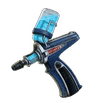
A viscous, blue serum fills the receptacle attached behind the nozzle of this metallic injector. Three small panels on the side of the injector light up one at a time when touched—a color (red, blue, or green) can be selected as an object interaction. The injector contains only 1 dose of universal serum. The injected target regains 2d4 + 2 health and an additional effect depending upon the current color selection.
Red grants the recipient 2d8 temporary health and it has advantage on Fortitude saving throws to resist dehydration, drowning, sleep deprivation, starvation, and suffocation and to march or labor for hours without rest.
Green grants the recipient advantage on Nimbleness checks and when calculating fall damage, reduce any falling distance by 4 meters if it isn’t incapacitated.
Yellow grants the recipient immunity to low radiation and advantage on all saving throws against radiation effects. In addition, the serum restores one exhausted level lost to radiation.
Blue grants the recipient advantage on Athletics and Brawn checks and its carrying capacity doubles.
The enhancement bonus lasts for 1 hour.
Zortaphen

Zortaphen is a powerful anesthetic. A creature that takes a dose of zortaphen must succeed on a Difficulty 14 Fortitude saving throw or become unconscious for 1 hour; the unconsciousness takes effect 1d6 rounds after the failed save. A creature under the effects of zortaphen is numbed as well. Damage inflicted on someone put to sleep with zortaphen does not cause the sleeper to awaken. Awakening someone early requires a successful Difficulty 16 Medicine check as an action. Zortaphen is a poison and sleep effect. Zortaphen can be dangerous if too much is taken at once.
A skilled character can use a successful Difficulty 13 Medicine check to keep someone under the effects of zortaphen unconscious indefinitely by injecting a new dose every hour. On a failed Medicine check or if a second dose is administered without attempting a Medicine check, a victim already under the effects of zortaphen must succeed at a Difficulty 14 Fortitude saving throw or have its maximum health reduced by 3d6.
Utility
| Name | Cost | Weight |
|---|---|---|
| Access Card | — | — |
| Battery | 100 sp | ½ kg |
| Camera | 3,000 sp | 1.5 kg |
| Chemalyzer | 2,500 sp | 4 kg |
| Chipfinder | 4,500 sp | 2 kg |
| Commset | 6,000 sp | 1 kg |
| Cylex | 3,600 sp | ½ kg |
| Detonator | 500 sp | ½ kg |
| E-Pick | 25 sp | ½ kg |
| Emergency Beacon | 900 sp | 5 kg |
| Emergency Raft | 3,600 sp | 5 kg |
| Emergency Shelter | 18,000 sp | 7 kg |
| Fire Extinguisher | 6,000 sp | 3 kg |
| Force Field | 4,000 sp | ½ kg |
| Grappling Hook | 2 sp | 2 kg |
| Gravity Clip | 2,000 sp | ¼ kg |
| Grippers | 100 sp | 2 kg |
| Heavy Weapon Harness | 4,000 sp | 2 kg |
| Hologram Generator | — | ½ kg |
| Inertial Dampening Belt | 1,000 sp | 1 kg |
| Ion Tape | 100 sp | ½ kg |
| Jetpack | 1,000 sp | 5 kg |
| Lighter | 10 sp | ⅒ kg |
| Magboots | 5,000 sp | 3 kg |
| Medlance | 250 sp | ½ kg |
| Nanite Canister | — | ½ kg |
| Power Cable | 500 sp | ½ kg |
| Power Receiver | 5,000 sp | ½ kg |
| Quantum Box | 40,000 sp | 1 kg |
| Radiation Detector | 2,000 sp | 1.5 kg |
| Robojack | 30,000 sp | 1.5 kg |
| Signal Booster | 9,000 sp | 3 kg |
| Signal Jammer | 10,000 sp | 4 kg |
| Temporal Accelerator | — | ½ kg |
| Tracker Chip | 500 sp | ⅒ kg |
| Zipstick | 20 sp | ½ kg |
Access Card
An access card is a small strip of stiff plastic with a color-coded stripe on one side. Some access cards are further decorated with names or titles, or even photographs of long-dead crew members. An access card functions as a key—when swiped through an electronic lock (with a Use an Object action), an access card unlocks any lock of its color code or a color code of a lower rating. Although access cards do not consume energy themselves, they work in only electronic locks that currently have power. Among certain societies, access cards are also used as decorations, worn as affectations, and incorporated into ceremonial regalia.
Access cards must be encoded to specific locks before they can function. Often, all of the doors in a complex are keyed to a unique set of cards that don’t work on doors found in other complexes, much like a skeleton key might open all the doors in one castle but none in another. Coding an access card for specific locks requires a lock coder.
Battery

Most technological items are powered by electricity. While one can use the electricity provided by a generator, these are rare, expensive, and rarely portable. It’s more common and practical to charge such items with batteries. A battery looks like a small silver disk that’s etched with strange lines—some people have taken to calling batteries “silverdisks” and sometimes use them as coins. A battery contains 10 charges when full; to charge an item with a battery, one simply slips the disk-shaped device into the proper slot on the item.
The battery’s charge instantly fully depletes, and the item’s internal capacitors fill with 10 charges as it does so. If the item had fewer than 10 open slots in its capacity, the excess charges the battery once held are lost. A battery can be kept within an object indefinitely, or it can be ejected from the object for the purposes of recharging it or storing it elsewhere without affecting the item’s charge. Inserting or ejecting a battery is an object interaction.
Placing a battery in a generator’s charging slot can recharge it. However, each time a battery is recharged, there’s a 20% chance that the battery is destroyed in the process.
A destroyed battery is worth only 10 sp. The bulk of “silverdisks” in circulation today are destroyed batteries; one can tell a functional battery from a destroyed one by the way the circuitry seems to shimmer slightly when reflecting light. The circuitry in a charged battery glows with a soft blue radiance equal to that of a candle.
Camera

This handheld device can capture still photographs or record video. Images and videos captured by a camera can be displayed on the camera’s palm-sized screen.
The device has a capacity of 20 charges and uses 1 charge for every 30 minutes of video, 1 charge for 200 photographs, or 1 charge for every 15 minutes of viewing images on the screen. A camera can hold up to 2 hours of video footage and 200 photographs.
Chemalyzer

A chemalyzer is a handheld unit with an extendable wand tipped with a sampling nozzle. It grants advantage on all checks made to identify an unknown pharmaceutical, poison, chemical, or substance. It cannot aid in the identification of magical effects or items like potions.
The device has a capacity of 10 charges and uses 1 charge for every substance analyzed.
Chipfinder

A chipfinder is a handheld device fitted with a circular screen. When a chipfinder is activated, all active tracker chips within a certain radius appear as glowing dots on the screen, indicating the direction and approximate distance to each installed tracker chip, as well identification number for each chip. The screen can filter out unwanted data to make it easier to track a specific chip. A chipfinder has a range of 400 meters. This range is a signal, and can be enhanced by a signal booster or blocked by a solid enough barrier.
The device has a capacity of 10 charges and uses 1 charge every hour.
Commset

This handheld device allows for communication between two commset users. A commset carries audio and visual signals, and includes a built-in camera that can record all communications being broadcast. Communication between two commsets requires both users to tune their individual devices to the same frequency. A commset has a range of 2 kilometers—beyond this range, communication is impossible without enhancing the signal strength with a signal booster. The price and cost listed for this item are for a single commset.
The device has a capacity of 10 charges and uses 1 charge every hour.
Cylex
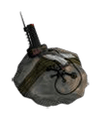
Cylex is an exceptionally stable form of explosive that can be shaped at room temperature, like soft clay. Neon green in color, a single charge of cylex can be triggered to explode by using a detonator (see below) or applying 10 or more lightning damage to it in a single attack. When detonated, a single use of cylex explodes in a 5-meter radius spread and deals 6d6 bludgeoning damage and 6d6 fire damage to all creatures and objects in the area of effect. A successful Difficulty 15 Reflex saving throw halves the damage.
Detonator

A detonator is a small device that can be used to trigger cranial bombs, cylex, and other explosives remotely. While an explosive is being set, the user can key the explosive to a detonator as an Action that costs the detonator one charge. Once the explosive is keyed, as an Action the user can push a button to trigger the explosive. A typical detonator has a range of 400 meters—though some may have a reduced range (intentionally or otherwise) and others might be enhanced by a signal booster.
The device has a capacity of 10 charges and uses 1 charge each time it is used.
E-Pick

An e-pick (short for “electronic lock pick”) is a small device that can be used to unlock and disable electronic locks and devices, much in the same way that a set of thieves’ tools can be used to dismantle mechanical locks and devices.
The device has a capacity of 10 charges and uses 1 charge each time it is used.
Emergency Beacon
rare, (900 sp, 5 kg)An emergency beacon is a small, pod-shaped device that emits a bright red flash from a dome on its top once every 6 seconds when activated. The beacon also transmits its location. Any device capable of receiving signals of any sort can pick up a beacon’s signal, which can then be tracked back to the source with a successful Difficulty 14 Streetwise or Wilderness check. A beacon’s transmissions have a range of 150 kilometers over flat terrain, but this range is halved in forests or hills, and quartered in mountainous terrain or through water.
The device has a capacity of 30 charges and uses 1 charge every hour when activated.
Emergency Raft
rare, (3,600 sp, 5 kg)An emergency raft initially looks like a bright red plastic cylinder, 15 centimeters wide and 60 centimeters long. When activated, it rapidly inflates into a tough little boat that measures 2 meters long, 120 centimeters wide, and 60 centimeters deep. It can hold four Medium creatures. The raft comes with two pairs of collapsible, dense plastic oars to row with. The raft can be commanded to compact back into its portable shape at a touch of a button, as long as no foreign objects or creatures remain inside. An emergency raft only consumes charges when commanded to unfold or compact.
The device has a capacity of 10 charges and uses 1 charge each time it is used.
Emergency Shelter
very rare, (18,000 sp, 7 kg)An emergency shelter is a small, 60-centimeter-long egg-shaped device that can be activated with the touch of a button (a Use Object action). Once activated, the shelter rapidly unfolds and inflates into a 2-meter radius hut capable of providing shelter for up to six Medium creatures. This process takes 1 minute to complete. The shelter includes pneumatic spike anchors that can attach it to any ground cover softer than metal. Several windows allow those inside to see outside. The interior contains several fluorescent lights. The shelter can withstand winds of up to 120 mph, and provides excellent insulation for those inside, maintaining a temperature between 10 and 30 degrees Celsius. A small combination heater/air scrubber set on the floor near the entrance to the shelter controls the temperature and purifies any noxious external air into breathable air. The hut has immunity to fire and cold and resistance to acid.
The dense plastic walls have 15 Defense and 10 Health. The hut cannot float on water. The door is self-sealing, allowing anyone inside an emergency shelter to live in inhospitable conditions with ease for as long as the power holds out. As long as no foreign objects or creatures remain inside an emergency shelter, it can be commanded at the touch of a button to compact back down into its portable shape over the course of 1 minute. After this point, the device consumes 1 charge over the course of 8 hours resetting its internal structure, limiting its deployment to 3 times a day at most.
The device has a capacity of 60 charges and uses 1 charge every hour.
Fire Extinguisher

This cylindrical device has a nozzle at one end and a handle on one side. As an action, a fire extinguisher creates a 3-meter cone of misty vapor that swiftly extinguishes fires within its area of effect. Against magical fire effects, such as those created by a wall of fire or similar spell, the fire extinguisher only extinguishes the part of the larger effect its vapors directly contact. Continual magic flames, such as those of a flaming weapon or fire creature, are suppressed for 1 minute before they automatically reignite. To extinguish an instantaneous fire effect or spell, the wielder must ready an action with the fire extinguisher to counter the effect; this can cancel the entire effect, provided the source of the effect is in the extinguisher’s area of effect.
When used against a creature made of fire, a creature must succeed on a Difficulty 14 Reflex saving throw or a blast from a fire extinguisher deals 4d6 cold damage, or half as much on a successful save. A breathing creature exposed to a direct blast from a fire extinguisher is not harmed as long as the area is relatively well-ventilated—using a fire extinguisher in a confined area with poor or no ventilation can result in slow suffocation (at the GM’s discretion).
The device has a capacity of 10 charges and uses 1 charge each time it is used.
Force Field

Force fields are powered by a surprisingly light pair of slender, silvery bracelets. When activated a sphere of shimmering force encloses you. Nothing—not physical objects, energy, or other spell effects—can pass through the barrier, in or out, though a creature in the sphere can breathe there. The sphere is immune to all damage, and a creature or object inside can’t be damaged by attacks or effects originating from outside, nor can a creature inside the sphere damage anything outside it.
The sphere is weightless and just large enough to contain the creature inside. An enclosed creature can use an action to push against the sphere’s walls and thus roll the sphere at up to half the creature’s speed. Similarly, the sphere can be picked up and moved by other creatures.
A disintegrate spell targeting the globe destroys it without harming anything inside it.
The device has a capacity of 20 charges and uses 1 charge every round.
Grappling Hook
(2 sp, 2 kg)As an action, you can secure a grappling hook. Make a Nimbleness check check (Difficulty 10, +2 for every 2 meters of distance the grappling hook is thrown, to a maximum Difficulty of 20 at 10 meters). Failure by 4 or less indicates that the grappling hook initially holds, but comes loose after 1d4 rounds of supporting weight. Failure by 5 or more indicates that the hook fails to catch and falls, allowing you to try again. This check is made secretly, so that you don’t know whether the rope will hold your weight.
Gravity Clip
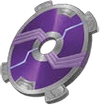
A gravity clip is a small, disc-shaped device that can be attached to any melee weapon. Once mounted, the clip modulates the weapon’s mass on the moment of impact, via the manipulation of the gravity fields around the weapon. Each successful hit against a target consumes a charge from a gravity clip and causes 1d4 extra damage.
The device has a capacity of 10 charges and uses 1 charge each time it is used.
Grippers

Grippers are powerful, long-handled tools that resemble a blacksmith’s tongs. Once they’re set, they can be locked into place to grip an object. Used when attempting to pry open a stuck object (in a manner similar to the use of a crowbar), grippers grant advantage on Brawn checks. When used to attach two devices, a set of grippers holds on with an effective +4 Strength. Applying grippers to a creature and then locking the grippers to crush flesh and bone is a melee attack and, once locked, the grippers deal 1d6 + 4 bludgeoning damage.
Heavy Weapon Harness

Known also as an “H-belt,” a heavy weapon harness is an elaborate network of plastic and metal struts and straps. A heavy weapon harness provides its wearer with additional stability and support, allowing the user to wield heavy weapons as if they were regular weapons.
Hologram Generator
| Color | Capacity | Range | Will Save Difficulty | Cost |
|---|---|---|---|---|
| Brown | 500 sp | |||
| Black | 1,000 sp | |||
| White | 2,000 sp | |||
| Gray | 4,000 sp | |||
| Green | 30,000 sp | |||
| Red | 40,000 sp | |||
| Blue | 50,000 sp | |||
| Orange | 60,000 sp | |||
| Prismatic | 90,000 sp |

A hologram generator is a handheld device with a long, thin barrel. It manipulates photons and sound waves to produce highly realistic images and sounds, similar in nature to those generated by the image spell augmented to major image. Before a hologram generator can generate an image, though, it must store the image in its memory. The maximum size and maximum number of images a generator can store vary according to its color, but storing an image is an action regardless of the strength of the generator. More powerful generators can store moving images and sounds, or even generate illusions that interact with their environments.
Once a hologram generator’s memory is full, additional images overwrite existing images as chosen by the user at the time of their recording.
Generating a hologram is an action. If the hologram generator is then left alone, it continues to project the image until it depletes its charges.
A hologram generator is a color-coded item, and the particulars of its abilities, including its energy capacity, the range at which it can create its holograms, and the Will save Difficulty to disbelieve the hologram if it is interacted with, vary as detailed below.
The device has a capacity based on its color and uses 1 charge every round.
Inertial Dampening Belt

When activated, an inertial dampening belt anchors the wearer in place, protecting her against outside forces. This effect gives the wearer advantage on Strength and Dexterity checks and Reflex saving throws to avoid a grapple, being pushed, and being knocked prone. If the wearer falls from a height of greater than 2 meters, the inertial dampening belt automatically activates just prior to impact and reduces the falling damage by half, consuming 1 charge per die of falling damage. If the belt has insufficient charges to reduce the entire amount of damage, the damage is not reduced for the excess dice. Damage from landing on hazardous objects such as spikes is not reduced.
The device has a capacity of 20 charges and uses 1 charge every minute.
Ion Tape

Ion tape is a ribbon of material tightly wound around a spindle. A roll of ion tape fits in the palm of a hand and comes in a wide range of colors. A single roll contains 10 meters of tape. A single strip of tape is easy to cut through or tear. When wrapped around an object, it has a weak adhesive that keeps it in place. When ion tape is exposed to an electrical charge of any power (including a jolt from a zip stick), the tape bonds together into a single mass of plastic-like material, gaining 15 Defense and 30 Health. When used to bind a creature, a few strips of activated ion tape require a successful Difficulty 20 Brawn check to break.
A second jolt from an electrical source causes the tape to revert to its weaker ribbon condition, at which point it can be torn free easily. A strip of ion tape can hold about 2 kilos of weight normally, but when activated via a jolt, a single hardened strip can support up to 150 kilos of weight. The uses for ion tape are many—it can be used to construct basic objects (such as a ladder), patch holes, bind prisoners, and so on.
Jetpack

A jetpack consists of a pair of cylindrical tanks worn on a shoulder harness with a pair of motion-sensitive rings worn on the thumbs that are used as wireless thrust and attitude controls. The jetpack can be activated as an action and grants a fly speed of 10 meters. The exhaust isn’t hot or concentrated enough to be used as a weapon.
A jetpack can be operated in overdrive, giving the wearer a fly speed of 20 meters and consuming twice as many charges per round.
While it is normally possible to wear an item in the shoulders slot as well as an item on the back, a jetpack’s bulk precludes the wearer also using a backpack, handy haversack, or other items worn on the back.
The device has a capacity of 100 charges and uses 1 charge every round it provides propulsion.
Lighter

This small handheld tool creates a tiny open flame when activated. Once triggered, a lighter’s flame (which gives illumination as a candle) continues to burn as long as the lighter’s trigger is depressed. The flame can be used to light larger items on fire, but is not large enough to cause significant damage on its own.
The device has a capacity of 10 charges and uses 1 charge every hour.
Magboots
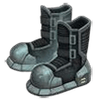
These clunky-looking boots have powerful electromagnets built into their soles that activate and deactivate automatically as the wearer flexes her foot, allowing her to walk on a metal surface with relative ease in zero gravity. While you wear these boots, you can move up, down, and across vertical metal surfaces and upside down along ceilings, while leaving your hands free. You have a climbing speed equal to your walking speed. However the boots don’t allow you to move this way on a slippery surface, such as one covered by ice or oil.
Medlance

This wand-like device contains a reservoir at one end and a small pad at the other. A medlance can be filled with a single dose of liquid, such as a pharmaceutical, a potion, or a poison. It can then be used to administer the liquid to a creature. If the target does not wish to be injected with the medlance’s contents, the wielder must make an attack to dispense it. Otherwise, administering liquid via a medlance is a Use an Object action. A medlance doesn’t use charges, but after being used to administer 10 injections, its internal sterilization mechanisms are depleted and the device becomes useless.
Nanite Canister
| Color | Heal | Mana | Cost |
|---|---|---|---|
| Brown | 2d8+1 | 1 | 500 sp |
| Black | 3d8+2 | 2 | 1,000 sp |
| White | 4d8+3 | 3 | 2,000 sp |
| Gray | 5d8+4 | 4 | 4,000 sp |
| Green | 6d8+5 | 5 | 30,000 sp |
| Red | 7d8+6 | 6 | 40,000 sp |
| Blue | 8d8+7 | 7 | 50,000 sp |
| Orange | 9d8+8 | 8 | 60,000 sp |
| Prismatic | 10d8+9 | 9 | 90,000 sp |

A nanite canister is used to power technological devices that use nanites—such items generally don’t require other sources of power, as the nanites themselves do the bulk of the work when the object is activated. The canister contains a small, independent power source and a supply of nanites. A single canister contains enough nanites to provide 10 charges for a nanotech item or weapon.
Nine categories of nanites exist along the color code scale, as detailed below.
Power Cable
common, (500 sp, ½ kg)A power cable is a short length of flexible cord, typically no more than 1 meter long, that can be used to attach a technological device to a power generator. It takes an object interaction to attach a cable to a generator or a device. Once connected, the item draws power from the generator rather than from its internal battery stores. If an item can be recharged, it automatically replenishes its missing charges from the generator (up to the generator’s available yield for that hour). This process is instantaneous.
Power Receiver

A power receiver is a device that attaches to any technological item’s battery slot. The power receiver is then set to the same frequency as a nearby power generator capable of broadcasting power, after which the device draws power from the generator as if it were attached via a power cable. The generator determines the range at which the device can draw power; this signal can be enhanced by a signal booster or blocked by a signal jammer.
Quantum Box

This silvery box holds up to half a cubic meter of items or material. Quantum boxes always exist as a pair. When activated as an action, a quantum box connects to its mate, at which point they trade contents. A quantum box must be activated again to switch the contents back. Effects that prevent dimensional travel block activation of a quantum box, but items that block signals do not. This effect works only if both quantum boxes are located on the same plane.
The device has a capacity of 10 charges and uses 10 charges each time is is activated.
Radiation Detector

This device measures radiation levels in a 20-meter radius circle. When activated, the device makes a soft clicking sound that changes in volume and frequency according to the radiation level encountered. A small screen on the top of the handheld device indicates the approximate source and strength of radiation in these areas, with red areas indicating severe radiation, yellow high radiation, green medium radiation, and blue low radiation. Areas with less radiation don’t register on the device’s screen.
The device has a capacity of 10 charges and uses 1 charge every hour.
Robojack

A robojack is a strange, rod-like device that can be used to usurp control of an otherwise functional robot. In order to gain control of a robot, the wielder must first make a ranged weapon attack against a target robot within a range of 10 meters. On a hit, the robot must succeed at a Difficulty 14 will saving throw to prevent the robojack from linking to the robot’s command processor. On a subsequent turn after a link is established, the wielder can issue a command to the robot as an action—each attempt to do so consumes 1 charge from the robojack, and the robot gets a new Difficulty 14 Will saving throw to resist following each command. The wielder must be within 10 meters of the robot and must issue the command in a language understood by the robot. The types of commands he can issue are similar to those allowed by a suggestion spell—once a command is successfully issued, the robot does its best to carry out the orders over the course of the next hour. This does not drain further charges from the robojack.
The device has a capacity of 10 charges and uses 1 charge each time it is used.
Signal Booster

This spherical object is the size of a human head. When it’s activated, several panels on its surface fold back and extend dozens of arms tipped with cup-shaped flashing lights. Once activated, a signal booster amplifies the strength of any signal-based technology effect within 200 meters, doubling the effective range of the signal. For example, a commset normally has a range of 2 kilometers, but in the area of effect of a signal booster, this range increases to 4 kilometers.
The device has a capacity of 10 charges and uses 1 charge every hour.
Signal Jammer

This small device emits a low, hissing sound when activated. While active, a white noise generator creates a 10-meter radius spread in which all signals are completely blocked.
Temporal Accelerator

When placed on the back of the skull, this curved metal bar adheres to the skin and releases a network of microscopic probes that interface directly with the wearer’s brain. As a Use an Object Action, the device can be activated to stimulate the wearer’s brain into accelerated activity. For 1 minute, the wearer’s speed is doubled, it gains a +2 bonus to Defense, it has advantage on Reflex saving throws, and it gains an additional action on each of its turns.
If a temporal accelerator is activated more than once in a 24-hour period, the wearer suffers an exhausted level at the end of the device’s effect.
Tracker Chip
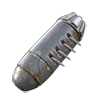
A tracker chip appears to be a bit of metal the size of a small fingernail. Before a tracker chip activates, it must be implanted in a living creature just under the skin. This procedure takes 1 minute to perform. As part of the installation process, the installer attempts a Medicine check, the result of which is the Difficulty of noticing the implant. Once a chip is implanted, its ingenious bioelectric circuits are powered by nerve impulses in the implanted creature’s body.
Noticing an implanted tracker chip requires a successful Perception check equal to 5 + the result of the Medicine check used to implant the chip. Extracting an installed tracker chip is an action that requires a slashing weapon or tool and deals 1 damage. Once installed, the tracker chip emits a signal that can be detected by any chipfinder in range.
If removed from a body or its host dies, an activated tracked chip retains enough of a charge to continue to be detected by a chipfinder for 1 week.
Zipstick

A zipstick is a small pen-like device used to administer a small jolt of electricity. This jolt is enough to deal 1 lightning damage with a successful melee attack. A zipstick is used most often to activate or deactivate items that function on ion-bonding technology, such as ion tape.
The device has a capacity of 10 charges and uses 1 charge each time it is used.
